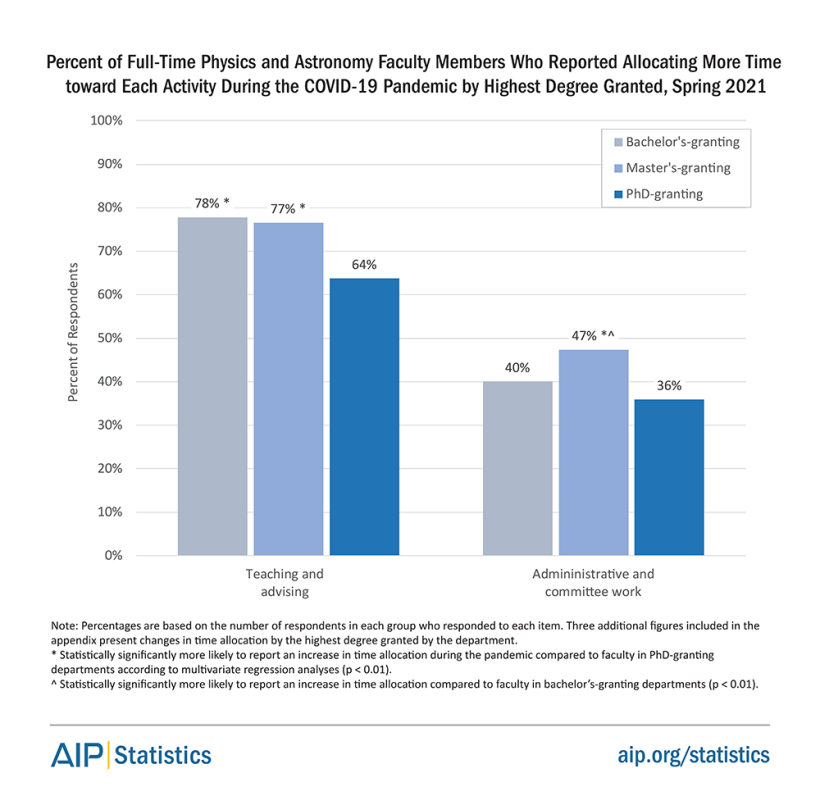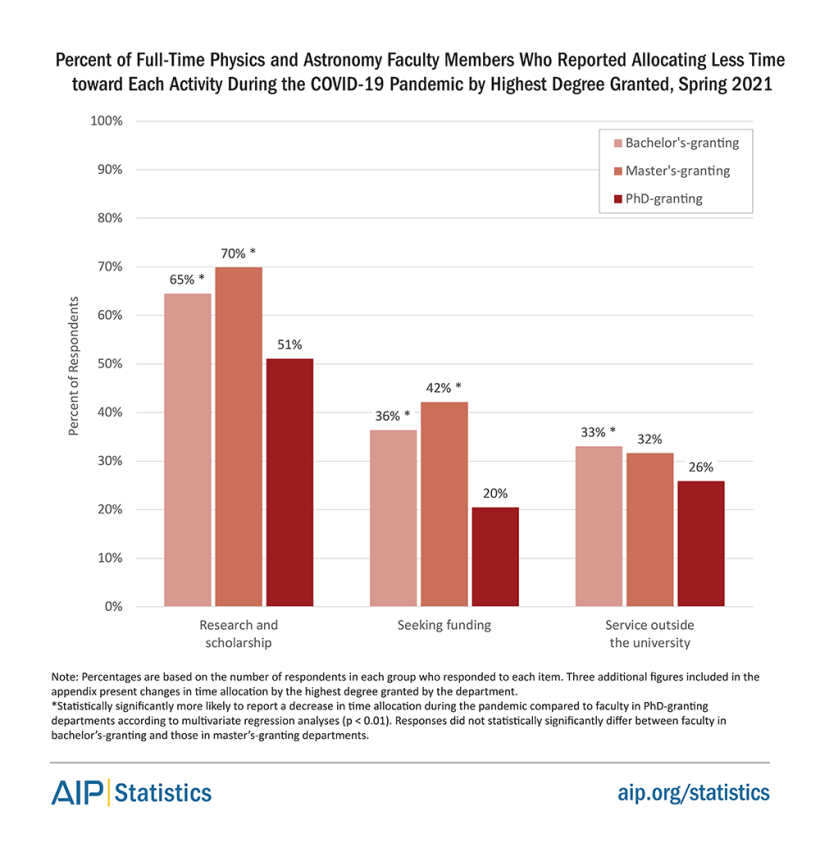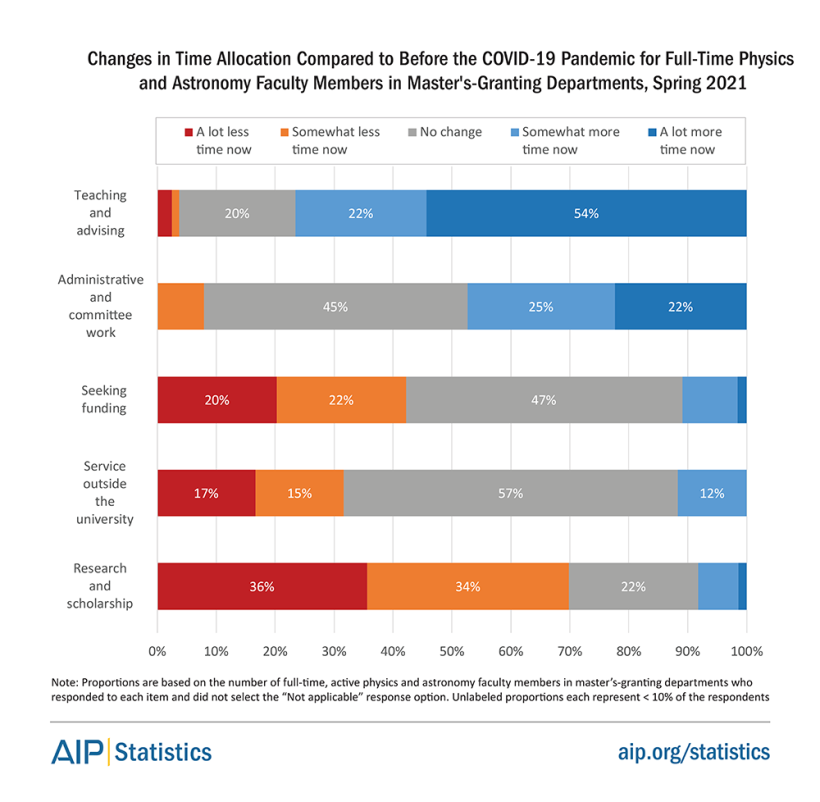Changes in Time Allocation During the COVID-19 Pandemic for Full-Time Faculty in Physics and Astronomy
Like many workers in the United States, physics and astronomy faculty members’ careers and work situations have been affected by the COVID-19 pandemic. During the spring semester of 2021, AIP’s Statistical Research Center surveyed a sample of faculty members regarding their experiences during the pandemic, and this Focus On outlines how faculty members have reallocated their time during compared to before the pandemic. The majority of full-time physics and astronomy faculty members indicated that they allocated more time to teaching and advising and less time to research and scholarship activities. Despite similarities across department types, faculty in bachelor’s and master’s degree-granting departments reported more changes in time allocation compared to faculty in PhD-granting departments.
In the spring of 2021, approximately 1,400 active faculty members from 282 US physics and/or astronomy departments shared how the pandemic impacted their time allocation, teaching and lab adjustments, access to resources, quality of work, and well-being. In this Focus On, we report changes in time allocation during the pandemic for the nearly 1,300 respondents who were employed as full-time, active faculty members in physics or astronomy when the survey was administered. We asked respondents, “Compared to your experiences prior to the COVID-19 pandemic, how has the time you spent in each of the following activities changed?” to which faculty members responded using a 5-point Likert scale from “A lot less time now” to “A lot more time,” with the option to select “Not applicable” for each activity we assessed.
In each type of department, regardless of highest degree granted, the majority of full-time physics and astronomy faculty members indicated that they spent more time teaching and advising compared to before the pandemic (Figure 1). On the other hand, the majority of faculty members in bachelor’s- and master’s-granting departments and nearly half of faculty in PhD-granting departments reported spending less time in research and scholarship. Trends were similar across all three department types, so we present the general trend in Figure 1. We also present changes in time allocation by highest degree granted in the department in the appendix.
Figure 1

While there were some consistencies in faculty members’ time allocation across department types, according to multivariate regression analyses (see Survey Methodology for more details), changes in time allocation also varied based on the highest degree granted by the department. Specifically, although the majority of faculty in all three types of departments reported an increase in time allocated to teaching and advising, respondents employed in departments granting either bachelor’s degrees or master’s degrees were more likely to report an increase in time allocated toward this responsibility compared to respondent in PhD-granting departments (Figure 2). Additionally, respondents employed in departments granting master’s degrees were more likely to report an increase in time allocated toward administrative and committee work compared to respondent in either bachelor’s degree- or PhD-granting departments.
Figure 2

On the other hand, although the majority of faculty in all three types of departments reported a decrease in time allocated to research and scholarship, respondents employed in departments granting either bachelor’s degrees or master’s degrees were more likely to report a decrease in time allocated toward this responsibility as well as toward seeking funding compared to respondents in PhD-granting departments (Figure 3). Respondents employed in departments granting bachelor’s degrees were also more likely to report a decrease in time allocated toward service outside the institutions compared to respondents in PhD-granting departments.
Figure 3

Conclusions
This Focus On reports data that show the ways in which time allocation has shifted in the spring of 2021 compared to before the COVID-19 pandemic for full-time, active faculty members in physics and astronomy. Regardless of the highest degree granted by the department, most faculty members reported reallocating their time in various ways. It is important to note that experiences varied across faculty members, even within department types. In future publications, we will dissect the trends presented here to determine how changes in time allocation differed across faculty members’ identities (e.g., gender and racial or ethnic identities) and positions within their department (e.g., current rank).
Although not presented here, we have found that the well-being of faculty members has deteriorated during the pandemic (see related Focus On [1] here ), which may be related to the changes we described here, in addition to other challenges faculty members faced, such as reduced access to resources (see related Focus On [2] here ) and adjustments to their courses and labs. Additional analyses are needed to understand the connections among faculty member experiences, which we plan to explore.
Survey Methodology
The American Institute of Physics Statistical Research Center most recently administered the Faculty Member Survey (FMS) in the spring of 2021. The FMS focuses on the demographics, training, and experiences of faculty members. In this cycle, the survey also included a special section on the impact of the COVID-19 pandemic.
Sampling Procedure
Across all 4-year colleges and universities in the US, we identified approximately 800 physics and astronomy departments, which employed an estimated 11,000 faculty members. A diverse sample of 315 departments (39%) was selected across physics and/or astronomy departments which granted bachelor’s degrees, master’s degrees, PhDs, or only graduate degrees.[a] We oversampled Historically Black Colleges and Universities (HBCUs; 100%) to try to ensure that enough faculty members who identified as Black or African American were included.
From each sampled department, we collected all faculty members’ names and contact information from the department websites. All faculty members listed within those departments (approximately 5,500) were emailed a link to complete the survey.
Nearly 1,800 (33%) individuals from 286 departments responded to the questionnaire; however, nearly 1,300 respondents were included in this Focus On. Respondents who indicated they were not active faculty members in physics or astronomy or who were not currently working at the institution from which we collected their contact information were removed from the sample. Nearly half of active faculty members included in this Focus On were full professors (49%), while fewer were associate professors (21%), assistant professors (19%), or in other faculty roles (11%).[b]
Analyses
In order to test the research questions in this report, we conducted a series of multivariate regression analyses, which allowed us to test any associations between department type and changes in time allocation while accounting or controlling for other potentially confounding effects. In order to isolate the effects of department type, each regression analysis included the following characteristics in each model.
• Gender identity
• Citizenship
• Race or ethnicity
• Marital status
• Parent status
• Other dependents status
• Faculty rank
• Time since earning degree
• Department field (i.e., physics, astronomy, or combined)
• Institution type (i.e., public or private)
a Specifically, we used stratified random cluster sampling to ensure that a relatively equal proportion of departments were selected from eight types of departments, based on the highest degree granted and the field of study in the department. Overall, the sample included 39% of physics or combined physics and astronomy departments in which the highest degrees granted were bachelor’s degrees (38%), master’s degrees (38%), PhDs (34%) or which only offered graduate degrees (38%). We also included 33% of departments which only offered astronomy degrees (50% of bachelor’s-, 50% of master’s, 25% of PhD-, and 50% of only graduate degree-granting departments).
b These numbers are similar to those collected in AIP’s Academic Workforce survey, in which the chair from each physics and astronomy department in the US was asked to report the number and rank of all faculty members in the department. In the data used for this Focus On, there are more faculty in full, associate, and assistant positions and fewer in other faculty roles because we only included data from full-time faculty here.
Appendix
Bachelor’s Degree-Granting Departments
Figure 4

Master’s Degree-Granting Departments
Figure 5

PhD-Granting Departments
Figure 6

References
[1] Walsh and Tyler (2022). Physics and Astronomy Faculty Members’ Well-Being of During the COVID-19 Pandemic .
[2] Walsh and Tyler (2022). Changes in Access to Resources During the COVID-19 Pandemic for Faculty Members in Physics and Astronomy .
e-Updates
You can sign up to receive email alerts that notify you when we post a new report or resource. Visit https://www.aip.org/statistics/stats_subscribe to sign up. We will send you an e-Update only when we post something new. You should receive no more than 20 messages in a year.
Follow Us on Twitter
The Statistical Research Center is your source for data on education, careers, and diversity in physics, astronomy, and other physical sciences. Follow us at @AIP_Stats.
Changes in Time Allocation During the COVID-19 Pandemic for Faculty Members in Physics and Astronomy
By Courtney Walsh and John Tyler
Published: December 2021
A product of the Statistical Research Center of the American Institute of Physics
1 Physics Ellipse, College Park, MD 20740
stats@aip.org | 301.209.3039 | aip.org/statistics
